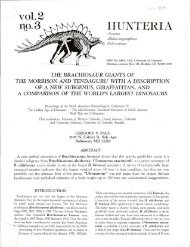THE MANY MYTHS, SOME OLD, SOME NEW, OF ... - Gregory S. Paul
THE MANY MYTHS, SOME OLD, SOME NEW, OF ... - Gregory S. Paul
THE MANY MYTHS, SOME OLD, SOME NEW, OF ... - Gregory S. Paul
You also want an ePaper? Increase the reach of your titles
YUMPU automatically turns print PDFs into web optimized ePapers that Google loves.
DINOSAUR <strong>MYTHS</strong> 79<br />
<strong>THE</strong> METABOLIC RATES AND OR <strong>THE</strong>RMOREGULATORY<br />
PERFORMANCE <strong>OF</strong> BIG ANIMALS CONVERGE,<br />
RESULTING IN GIGANTO<strong>THE</strong>RMY<br />
Myth: The metabolic rates of reptiles scale to a higher exponent than the 3/4's value<br />
seen in birds and mammals, and large size confers a degree of homeothermy<br />
regardless of internal heat production. This means that the physiological performance<br />
of all large animals is similar, blurring the distinctions seen between smaller<br />
forms, and resulting in a universal "gigantothermy" (term coined by Paladino et al.,<br />
1990; also see Hotton, 1980; Ricqles, 1980; Spotila, 1980; Dunham et al., 1989).<br />
Reality: Large reptiles do enjoy much more stable body temperatures than smaller<br />
ones, but otherwise the concept of convergent gigantothermy is greatly overstated.<br />
The various exponents for the scaling of reptilian metabolic rates range from 0.62 to<br />
0.82, with some near 0.75. This means there is no clear evidence supporting the<br />
metabolic convergence. Instead, the metabolic rates, food consumption and biomass<br />
densities of large crocodilians, monitors, snakes, and giant tortoises differ by a factor<br />
of six to ten or more times from those of mammals of similar size and trophic habits,<br />
supporting a continued separation in line with a 3/4's scaling. Leatherback sea turtles<br />
do not support a convergence between the metabolics of reptiles and mammals,<br />
because according to the data presented in Paladino et al. (1990) their metabolic rates<br />
may be elevated above those of other reptiles, and match those of some mammals.<br />
The models by Spotila et al. (1973), Spotila (1980), Dunham et al. (1989) and<br />
Paladino et at. (1990) differ on whether large, bradymetabolic dinosaurs would have<br />
been as seasonally homeothermic as mammals and birds, or would have experienced<br />
widely fluctuating seasonal body temperatures.<br />
Much the same metabolic gradation seen in reptiles, insectivores, marsupials, and<br />
placentals of 10 g to 1 kg can be seen in big animals as well, showing that there is no<br />
such thing as gigantothermy. Giant tortoises and pareisaurs with SMR's of 4-8 kcal/<br />
kg 0.75/day have short sprawling or semi-erect limbs, relatively simple food gathering<br />
apparatus, and low held heads. Giant edentates had dental batteries and double<br />
pump hearts that allowed them to carry their heads high, and limbs were erect, but<br />
the heavy, awkward legs and feet show that foraging ranges were limited, and mass<br />
specific SMR's were probably only 20-40 kcal. Big marsupials either had heavy,<br />
awkward footed limbs that indicate short foraging ranges, or highly efficient hopping<br />
legs, and SMR's are from 40-60 kcal. Elephants, ungulates and ratites with SMR's of<br />
55-85 kcal have long legs with feet well designed for walking at high cruising speeds<br />
in search of forage, and their necks are sometimes very tall. Energetics do make a lot<br />
of difference in body design, and vice versa, whether one masses 10 grams or 10<br />
tonnes.<br />
BIG TACHYMETABOLIC DINOSAURS WOULD HAVE<br />
COOKED IN <strong>THE</strong> HEAT<br />
Myth: Because tachymetabolic rates scale to WO.75, while surface area scales to<br />
WO.67, it is almost universally believed that big endotherms suffer serious heat stress<br />
in tropical climes. Big dinosaurs, sauropods especially, should have had low metabolic<br />
rates to avoid this dire fate (Martin, 1979; Regal and Gans, 1980; Spotila, 1980;<br />
Reid, 1984; Schmidt-Nielsen, 1984; Carroll, 1988; Alexander, 1989; Prothero, 1989;<br />
Russell, 1989). Alternately, tachymetabolic sauropods needed well developed cooling<br />
systems (Bakker, 1980, 1986).









